Internet on board: Fast Internet in every bay thanks to Starlink from Elon Musk
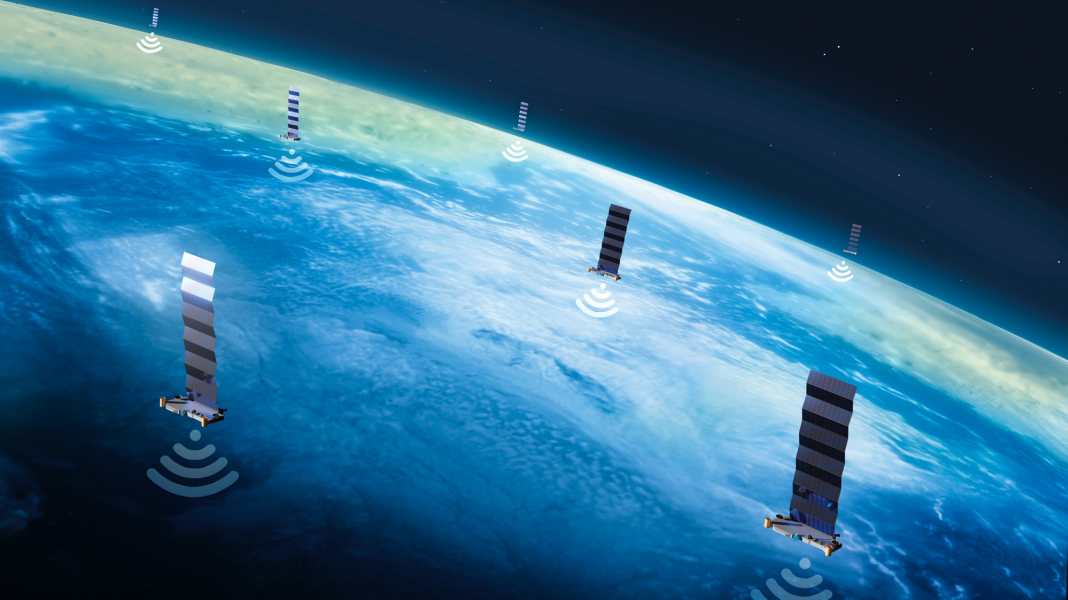
from Heino Kuhlemann
Using the ship as a boat office, simply surfing the Internet, watching films, receiving reliable weather reports and even telemedicine at sea - the need for high-performance, reliable and economically viable access to the Internet has become increasingly important in recent years.
The trend is not new, but the coronavirus pandemic has significantly increased its acceptance. The desire to be able to work from anywhere has virtually reached the centre of society. Whether temporarily or permanently on your own ship or a charter yacht hardly plays a significant role.
Starlink at a glance- A dense satellite network ensures worldwide coverage
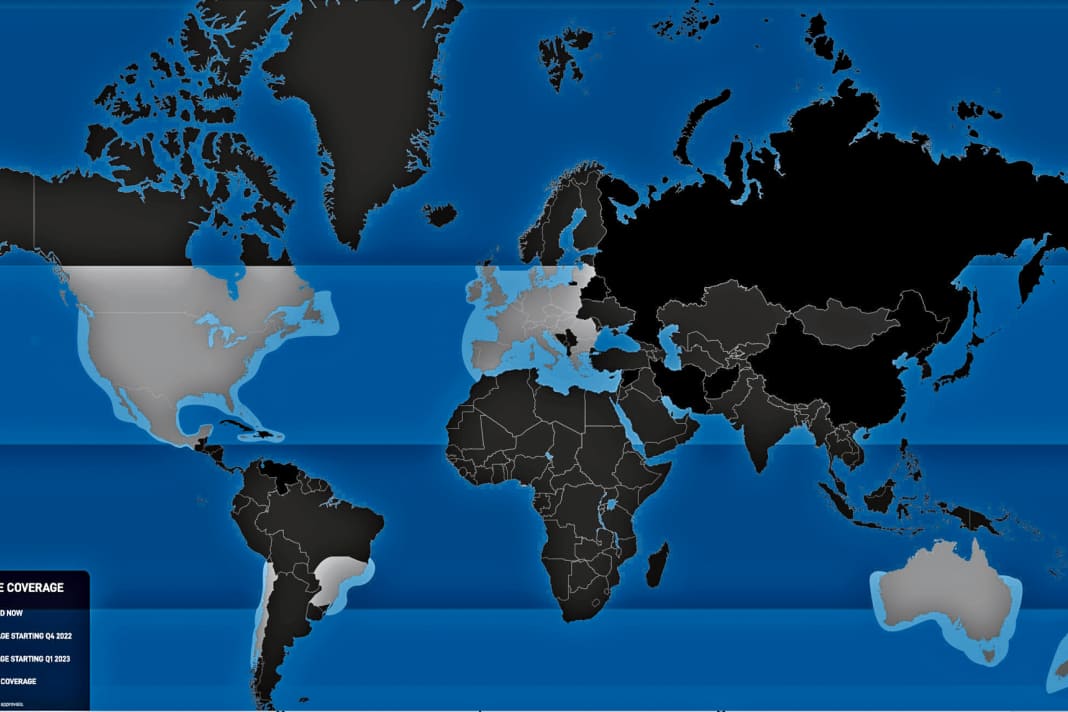



Starlink is part of Elon Musk's SpaceX space project and is intended to provide nationwide high-speed internet. The system officially went live at the end of 2021, but has not yet reached its full expansion stage, so coverage is not yet global. The service can already be used in large parts of Europe and North America.
A special feature of Starlink is the enormous number of satellites. The system currently operates with around 2,800 satellites, and is expected to have around 12,000 when fully expanded. By comparison, Inmarsat works with just four geostationary satellites. The large number of satellites is necessary because the artificial celestial bodies fly in orbits of no more than 550 kilometres in altitude. This ensures short signal propagation times and good response times for the data connection. However, the individual satellites can only cover small radio cells.
A side effect of the low orbits is the short service life of the satellites; they are so close to the atmosphere that increased friction occurs. The orbits therefore have to be corrected frequently and the fuel is quickly used up. The current generation will not last longer than five years. Communication satellites flying at higher altitudes generally last two to three times as long. The satellite chains are another special feature. SpaceX deploys around 50 satellites at a time during each launch, which are then grouped into chains of lights that are clearly visible at dusk before they take up their positions in the network.
Can Elon Musk's system be convincing in practice?
The author Heino Kuhlemann advises medical facilities and IT providers in the healthcare sector from the boat office during the summer and is therefore dependent on a reliable internet connection.
In our medical informatics company, mobile working is a long-standing practice. What began in the mid-1990s as e-mail retrieval with a modem on telephone sockets now requires completely different bandwidths, and Internet access must also be reliably available. A requirement that cannot be met everywhere with LTE or 5G. It was therefore an obvious choice to install Elon Musk's Starlink satellite internet system on board and test it intensively. Compared to Inmarsat or Iridium, Starlink promises enormous data rates and is even inexpensive.
In the tested version, which is actually intended for motorhomes, it costs around 100 euros per month. The hardware comes at a one-off cost of 460 euros.
Since August 2022, the Starlink RV system has been used alongside an LTE router for day-to-day video conferencing work. RV stands for Recreational Vehicle. Unlike the original versions, this version of Starlink is not tied to a fixed address and can be used at different locations.
In contrast to the Maritim version, which is also available, the Camper version comes with a simpler antenna and must not be used while driving. This would invalidate the warranty or could result in the account being blocked. Nevertheless, you can read in Facebook groups that some people use the RV version while travelling without any problems. We have limited ourselves to use at anchorage or in the harbour. Concentrating on video conferencing and sailing at the same time is not an option anyway. In addition, there is often very good LTE or 5G coverage near the coast. Problems usually only occurred directly in anchorages when mountains shadowed the mobile phone signal.
Hardware & power supply
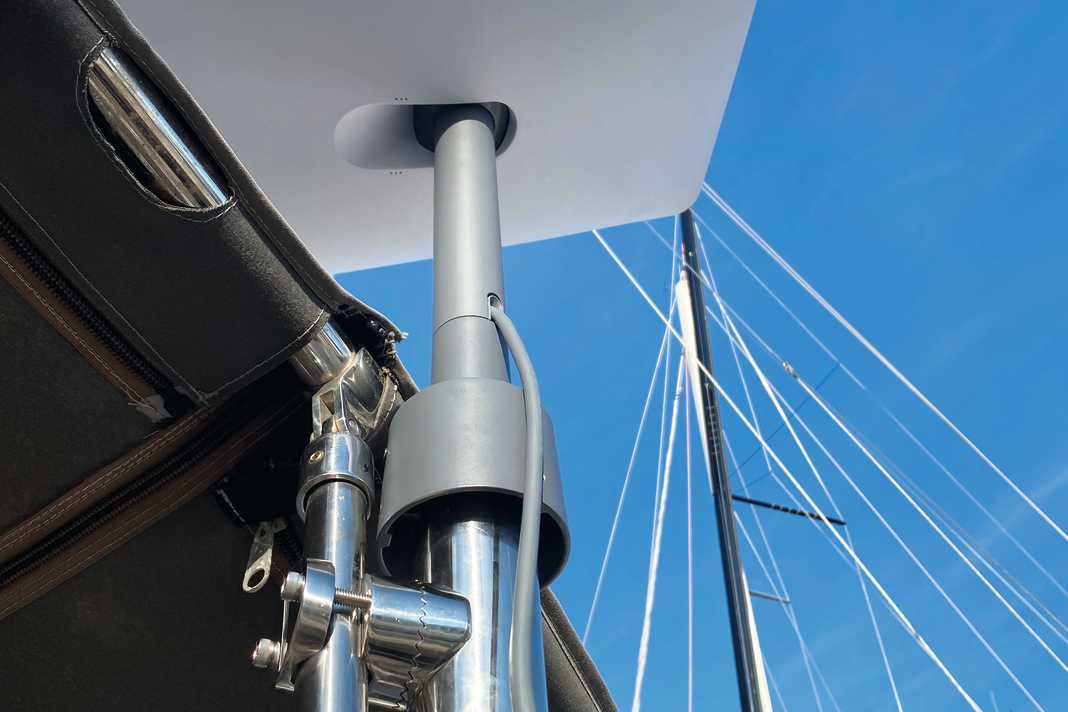




Orders can be placed online atwww.starlink.com just as uncomplicated as the delivery within a few weeks. The scope of delivery includes a router, which also has a sufficiently long cable with alternating current. The power consumption is between 25 and 45 watts. In order to have enough energy on board for longer working days, we use two mobile solar panels with a peak output of 100 watts each. With good sunshine and orientation, the panels deliver 50 to 60 watts each, which is sufficient to operate the laptop and Starlink.
However, as the sun doesn't shine every day and you might have to work a night shift if you're under deadline pressure, you should keep an eye on the power balance. That's why an additional power generator is on board as a backup.
Starlink aligns itself automatically
Once set up, Starlink can be plugged in on arrival on board and used in the marina, at a mooring or at anchor. The dish collects data first, so when you switch it on at a new location, you have to wait a little before you can use the full performance. You should allow five to ten minutes beforehand, so it's best not to start the video meeting straight away.
The system works with phased array technology, which means that the antenna can align itself electronically to the signal to a certain extent and does not have to be constantly mechanically adjusted to follow the satellites. Motors integrated into the dish therefore only occasionally correct the alignment of the antenna. Normal ship movements are not compensated for.
In US Facebook groups on "Starlink on Boats", you can read about some people who have deactivated the antenna motor. In view of the infrequent corrections, however, this is unlikely to reduce the system's power consumption, but such tinkering will invalidate any warranty claims.
The ultimate test: video calls at anchor in a bay with mountains all around and more wind
Television and video conferencing with common tools such as Teams or Zoom should show in a practical test how Starlink RV works at anchor or in a marina. In the fully occupied ACI Marina Opatija in Croatia, the ship was hardly moving, as it typically should be at berth. However, the direct view of the sky was blocked by the rigs of the neighbouring yachts.
Reports from the camping sector state that similar situations with nearby trees lead to reception problems. In our test, neither the large number of masts nor the neighbouring Mount Ucka had a negative impact on data transmission. Internet television and video conferencing worked perfectly for hours.
The next step was to drop anchor. In order to create a meaningful test, it was helpful that the shifting winds created a swell. In addition, the swell of the morning Tramontana from the bay of Volosko came into the anchorage and caused three-dimensional movement due to wind and waves.
Flawless connection despite wind and waves
A tolerable, but not optimal anchor situation. Although the antenna only follows the Schwoien with a delay and rolling and pitching movements were practically not compensated for at all, the connection was flawless. Video conferencing and streaming worked perfectly even under these conditions.
As the exemplary measurements show, the performance of the Schwoien certainly fluctuates, albeit at a fairly high level, which is more than sufficient for the aforementioned requirements in the boat office.
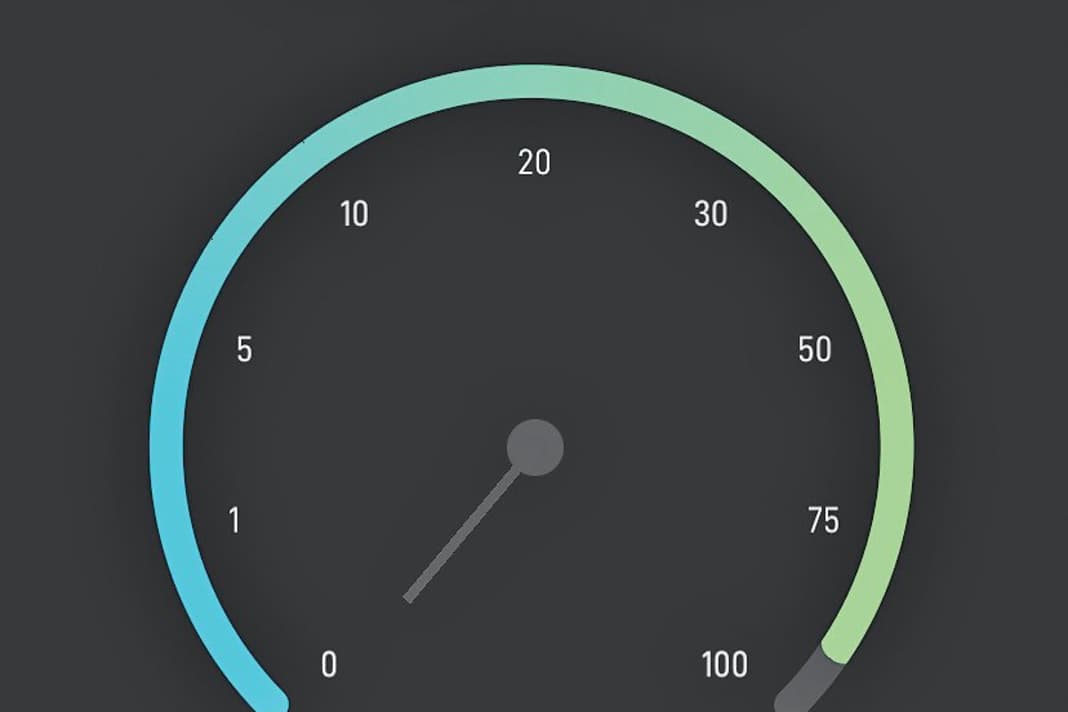



The result of days of use at anchorages can be summarised as follows: uninterrupted and very fast. No disruptions were detected. This is particularly remarkable, as short fluctuations and associated dropouts in video conferencing are common with LTE connections almost every day. However, the actual bandwidth of the satellite connection depends on the number of users and the utilisation of the network.
In the US media, you can read about significant declines in transmission speeds. However, the user density in some areas there is already so high that Starlink is no longer delivering new fixed systems. These enjoy a higher priority in the distribution of bandwidth. As a mobile user, you are always second in line and therefore have to expect restrictions.
At anchor or in the harbour - Starlink is recommended, but power consumption must be taken into account
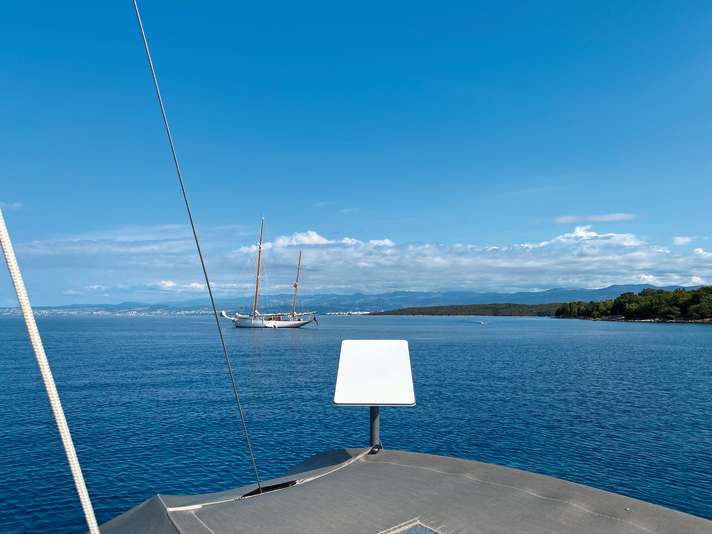
Starlink RV is a real alternative when no LTE or 5G network is available. However, the system is also suitable as the main solution for everyday mobile working. In a direct comparison with mobile phone networks, it even performs better than 5G. Only the power supply via 230 volts and the power consumption of around 40 watts are a hindrance and can limit its use on board.
That's why we only ever use Starlink at anchor when the mobile phone network is unreliable or not fast enough. In the marina with shore power, the satellite connection is now often our main access to the Internet on board. In the compact practical test, which of course cannot yet reflect years of experience, no faults have occurred so far.
Starlink: a sensible upgrade in many cases
The installation is very simple and easier to manage than most router set-ups at home. With the simple combination of a fishing rod holder and the pipe adapter from Starlink, a suitable place can probably be found on any boat. The important rule is to have as clear a view of the sky as possible - but who regularly anchors under bridges or treetops? We didn't notice any interference from neighbouring boats' rigs.
As far as costs are concerned, 460 euros to purchase and 100 euros per month are certainly economical if you can avoid breakdowns and disruptions and can drop anchor wherever you like. And if you can afford the convenience of high-quality Internet on board privately, the crew will certainly thank you for it.
For charter yachts, it may be an idea to install brackets in the sense of "bring your own Starlink". It is important to note that the RV version must not be used while underway. If that is enough for you, the system is highly recommended.
Recommended bandwidth
It remains to be seen to what extent the bandwidth will decrease with increasing distribution in Europe and whether the 1 terabyte cap will be introduced here as in the USA. But even with these uncertainties, Starlink is likely to be the most powerful and also the cheapest Internet solution for use in remote anchorages for the foreseeable future.
If you look at the bandwidth requirements of the Zoom video conferencing platform, for example, it quickly becomes clear that Starlink does not even come close to reaching its limits here.
The bandwidth used by Zoom is optimised based on the participants' network for the best experience. Adaptation for 4G, 5G, Wi-Fi or wired networks is automatic.
Recommended bandwidth for panellists in meetings and webinars:
For video calls with two participants:
- for high quality video: 600 KBit/s (upload/download)
- for 720p HD video: 1.2 MBit/s (upload/download)
- for 1,080p HD video: 3.8 MBit/s or 3.0 MBit/s (upload/download)
For video calls with groups:
- for high-quality video: 1.0 MBit/s or 600 KBit/s (upload/download)
- for 720p HD video: 2.6 MBit/s or 1.8 MBit/s (upload/download)
- for 1,080p HD video: 3.8 MBit/s or 3.0 MBit/s (upload/download)
- for receiving the gallery view: 2.0 MBit/s (25 views), 4.0 MBit/s (49 views)
- for screen sharing only (no video thumbnail): 50-75 KBit/s
- for screen sharing with video thumbnail: 50-150 KBit/s
- for audio VoIP: 60-80 kbit/s
- for Zoom Phone: 60-100 kbit/s
Recommended bandwidth for webinar participants:
For panellist video:
- ~600 KBit/s (download) for high-quality videos
- ~1.2-1.8 MBit/s (download) for 720p HD video
- ~2-3 MBit/s (download) for 1,080p HD video
For screen sharing only (no video thumbnail):
- 50-75 kbit/s (download)
For screen sharing with video thumbnail:
- 50-150 kbit/s (download)
For audio VoIP:
- 60-80 kbit/s (download)
Starlink received five out of five stars in the YACHT trial

